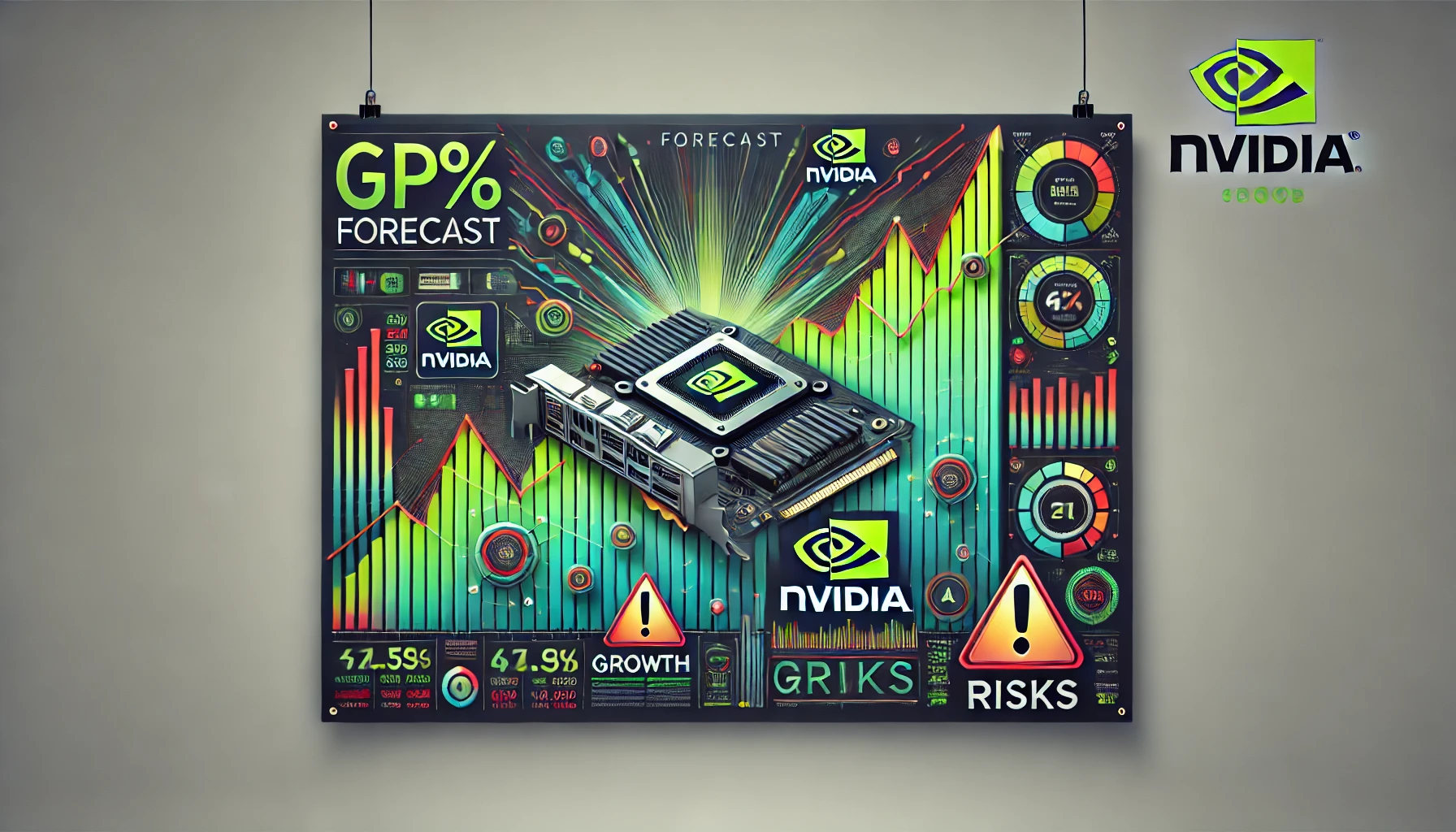Nvidia Stock Forecast: Understanding the Risks and Volatility for Future Growth
Nvidia Corporation, a key player in the semiconductor and AI industry, has been on a meteoric rise over the past few years. With significant advancements in artificial intelligence (AI) technology, data center applications, and gaming, Nvidia has attracted widespread attention from investors. However, despite the company’s impressive performance, there are growing concerns among top investors regarding Nvidia stock risk and the volatility surrounding its growth trajectory. As the market becomes increasingly competitive and macroeconomic conditions evolve, it’s essential to understand both the opportunities and risks that lie ahead for Nvidia.
In this blog, we’ll dive into Nvidia’s stock forecast, explore the challenges facing its AI growth, and evaluate the key risks that investors should not overlook. We’ll also examine the company’s valuation, recent stock splits, and financial metrics like gross margins, providing you with a comprehensive analysis of Nvidia’s current position in the market and its future potential.
Nvidia’s AI Growth: A Driving Force in the Market
How Nvidia’s AI Growth is Shaping the Future
Nvidia’s AI growth has been one of the primary drivers of its stock performance. The company’s dominance in AI chips, particularly those used for machine learning and data processing, has positioned it at the forefront of the AI chip market. Nvidia’s GPUs are critical components in data centers worldwide, powering AI applications from tech giants like Google, Amazon, and Microsoft. This has led to a surge in demand for Nvidia’s products, driving revenue growth and boosting investor confidence.
However, with great success comes increased scrutiny. Some investors have raised concerns about how much further Nvidia’s AI growth can extend. The competition in the AI chip market is intensifying, with companies like AMD and Intel ramping up efforts to capture market share. Additionally, while Nvidia is currently leading the data center market, its ability to maintain this position in the face of competition will be crucial for its long-term growth.
Nvidia’s Role in the Data Center Market
Nvidia’s influence on the data center market cannot be understated. Data centers are critical infrastructure for cloud computing, AI, and big data analytics, and Nvidia’s GPUs are central to these operations. The demand for Nvidia’s AI chips has surged as more companies build out AI capabilities, making data centers a pivotal growth driver for the company. However, as competition heats up in this space, Nvidia’s future growth in the data center market could be at risk if competitors introduce more affordable or powerful alternatives.
Investors need to keep a close eye on how Nvidia manages its AI growth in the face of increasing competition. Although Nvidia has maintained its lead thus far, the rapidly evolving landscape in AI and data centers means that the company will need to continue innovating to stay ahead.
Nvidia Stock Forecast: What Lies Ahead?
Nvidia Stock Risk and Volatility: What Investors Should Know
While Nvidia has seen remarkable success, its stock is not without risks. One of the primary concerns among investors is Nvidia stock volatility. Over the past few years, Nvidia’s stock price has experienced significant fluctuations, particularly as global markets have faced economic challenges. Nvidia’s stock is known for its high price-to-earnings (P/E) ratio, which some analysts argue makes it overvalued compared to other companies in the tech sector. This overvaluation can contribute to increased volatility, as any market correction could lead to sharp declines in Nvidia’s stock price.
Additionally, Nvidia operates in a cyclical industry, which means that periods of high demand (as seen with AI and gaming) could be followed by downturns. The global semiconductor industry is highly sensitive to macroeconomic factors, and any slowdown in consumer or business spending could impact Nvidia’s bottom line. Investors should remain cautious of these risks and consider how Nvidia stock risk may affect their portfolios, especially during periods of economic uncertainty.
Nvidia Stock Forecast: Future Growth Potential
Despite these risks, Nvidia’s stock forecast remains optimistic, with analysts projecting continued growth in the coming years. The company’s investments in AI, gaming, and autonomous vehicles provide significant growth opportunities. Nvidia’s leadership in the AI chip market is expected to continue, and its expansion into new sectors like robotics and edge computing could further bolster its revenue streams.
Analysts estimate that Nvidia’s revenue will grow at a compound annual growth rate (CAGR) of around 20% over the next few years, driven primarily by AI and data center demand. However, this growth is contingent on Nvidia maintaining its competitive edge and managing the risks associated with its high valuation and market volatility.
Nvidia Stock Valuation: Is It Overvalued?
Examining Nvidia Stock Valuation and Gross Margins
One of the most debated topics among investors is Nvidia stock valuation. Currently, Nvidia trades at a high multiple compared to its peers in the semiconductor industry, leading some investors to question whether the stock is overvalued. A key factor influencing Nvidia’s valuation is its high growth potential in AI and data centers, which has justified its premium valuation thus far. However, as the market matures and growth rates normalize, Nvidia may struggle to maintain such high valuations.
Another important metric to consider is Nvidia’s gross margin, which reflects the company’s profitability. Nvidia has consistently maintained strong gross margins, largely due to the high demand for its GPUs and the premium prices they command. However, as competition increases, Nvidia may face pressure to lower its prices, which could impact its margins and overall profitability.
Impact of the Nvidia Stock Split
In 2021, Nvidia announced a stock split, which made its shares more accessible to retail investors. While stock splits don’t inherently change a company’s value, they can influence investor sentiment by making the stock appear more affordable. Nvidia’s stock split was seen as a positive move, attracting a broader base of investors and driving up demand for its shares.
However, despite the enthusiasm following the split, Nvidia’s high valuation remains a concern. Investors should carefully consider whether the company’s growth potential justifies its current stock price, particularly in light of the risks mentioned earlier.
Navigating the Nvidia Stock Risks: Key Takeaways for Investors
Balancing Growth with Risk in Nvidia Stock
For investors, the challenge lies in balancing Nvidia’s impressive growth prospects with the inherent risks of owning such a high-performing stock. Nvidia’s leadership in AI, data centers, and GPUs positions it well for future growth, but its high valuation and market volatility mean that the stock could be subject to significant price swings.
If you’re considering adding Nvidia to your portfolio, it’s important to stay informed about both the opportunities and risks. Nvidia’s stock may offer substantial returns for those willing to ride out the volatility, but it’s essential to understand the potential downsides, particularly in the event of a market correction or increased competition.
Is Nvidia Stock a Good Investment?
Nvidia’s dominance in AI and data centers has made it a favorite among investors, and its future growth potential is undeniable. However, the risks associated with Nvidia stock volatility, high valuation, and competition should not be overlooked. As the company continues to expand its market share, investors must remain vigilant, balancing the potential for high returns with the understanding that Nvidia operates in a highly competitive and cyclical industry.
For more insights into investment strategies and market analysis, visit Regent Studies.
If you’re interested in further reading, check out this detailed Nvidia stock analysis for more information on the risks and opportunities ahead.



